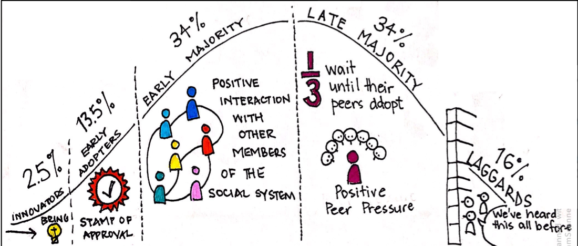Leading change and innovation by design: Who’s on your mini-bus?

Last week someone asked me,
“How would you describe what you do?”
You might think professional traveller, designer, speaker, facilitator, and there probably is plenty of reason for thinking that, and I do those things. But I’m a ‘gut instinct’ kind of person and the first thought was…
“transform culture“
I think about, live, breathe and I’m motivated by creating positive culture. Culture is defined as a “set of shared attitudes, values, goals, and practices that characterises an institution or organisation” (Merriam-Webster). We can create amazing spaces for work and learning, but unless we address the people-factor, the big vision will merely be a mist in time that quickly evaporates.
So, if you say “We want a culture of collaboration”,
What are you doing to transform this from a nice idea to reality?
Start with the right people on the mini-bus.

Turkish Online Journal of Educational technology, Vol 5., Issue 2.
The theory of ‘diffusion of innovations’ was developed by Everitt Rogers in 1962. It is one of the oldest social science theories, explaining how people respond to change, and aiming to increase the rate of adoption, while reducing uncertainty.
Cast vision as wide as possible, of course, but the actual work of transformation requires, as Collins wrote in Good to Great, the right people on the bus, in the right seats. But I believe it’s actually a minibus with key people on board to get the journey started, to ideate, prototype and test the ideas.

Rogers outline five key people groups in any organisation, innovators, early adopters, early majority, late majority and laggards.
To effectively increase the rate of adoption of an innovation, gather the ‘earlies’ – early adopters and some of the early majority. They possess the positive outlook to see possibilities and bring ideas to life. The innovators, the brave souls who champion change, need the early adopters who can see and realise possibilities. The late majority watch for confirmation for the early majority before taking the leap. The laggards, with white knuckles, hold tightly to the status quo, look to the past and gather a posse of like-minded people.
Laggards have the traditional view and they are more skeptical about innovations and change agents…their interpersonal networks mainly consist of other members of the social system from the same category.
(Sahin, 2006, p.20)
You may be tempted to bring the laggards in early, get them on working groups, steering committees, but don’t. In my experience, depending on how ‘laggardish’ they are, these people can use this as an opportunity to sabotage efforts for change. I learnt this the hard way. As I spoke to a whole staff, and then facilitated a workshop, a very vocal laggard (a mature teacher) behaved in a way that he would not accept from his own students and set back the school’s efforts to innovate.
An aspirational empathy map
Who is on your mini-bus, heading off on a reconnaissance mission to chart paths unknown?
I use empathy mapping in design thinking workshops to gain insight into the user experience – staff, student or client. This kind of empathy mapping starts where we are, understanding who we are working with.
But what about who we seek to be? I’ve asked leadership teams to think about the ‘Aspirational Empathy Map’. Then we can identify those closest to the description, your ‘earlies’. Of course, you know them anyway. They are always the ones excited by new opportunities and suggesting crazy ideas.
Design for the long haul
When I think about design, I think about people. Getting the right people on board the minibus in the early stages is essential. In his research, developing the school climate model, Gislason (2010) writes, “School design should be viewed as part of the network of elements that shape together the learning environment”.
The physical environment alone cannot support transformation. It starts with people.
First things first.
@anneknock
